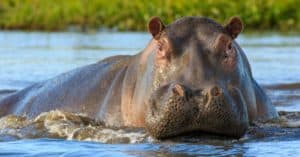Picture this: It’s a beautiful Saturday morning and you sit down to enjoy a large, steaming stack of pancakes, drenched in savory syrup with a fresh plate of crispy, mouthwatering hippo bacon. Yes, you read that right, hippo bacon. If the “American Hippo Bill” had successfully passed in 1910, then many of us would all be sitting down to this breakfast of “lake-cow” hippo bacon today.
You see, in the early 1900’s, the United States was facing two major problems: a nationwide meat shortage, and the invasion of a foreign aquatic plant. Robert F. Broussard, the U.S. representative from Louisiana at the time, believed he had the answer to solving both distinctly different problems. Broussard’s solution? To fill the Mississippi River with a herd of hippopotami.
Where Do Hippos Live?
Hippos are native to sub-Saharan Africa and they are typically found in a variety of freshwater habitats such as rivers, lakes, and swamps. They are most commonly found in the Nile River and its tributaries, as well as in the rivers of West and Central Africa, like the Congo River and the Niger River, and their tributaries.
Hippos aren’t naturally found in the U.S., especially in the Mississippi River.
They can also be found in smaller numbers in other parts of Africa, such as South Africa and Tanzania, but these populations are much smaller compared to the populations found in the aforementioned regions.
They prefer to live in deep waters and are known to be able to hold their breath for long periods of time, allowing them to submerge for extended periods of time.
How Long Do Hippos Live?
Hippos have an average lifespan of around 30 to 50 years in their natural habitat, however, some individuals have been recorded to live for up to 55 years.
They tend to have a shorter lifespan in captivity and can survive for 20 to 30 years.
What Do Hippos Eat?
Hippopotamuses are herbivores, meaning they eat plants. They mostly graze on short grasses and aquatic plants, such as water lilies. In addition to their plant-based diet, hippos may rarely consume small amounts of insects and other aquatic creatures.
Hippos find food by grazing in large herds or alone on the shoreline of rivers or lakes, depending on where they live. They can also dive beneath the surface while underwater to search for edible vegetation growing at the bottom of lake beds.
The average adult hippo consumes around 80 pounds of food every day! This is a combination of both land-based and aquatic vegetation that they usually find in their natural habitats. Hippos will spend up to 16 hours each day feeding themselves before taking a break for rest and relaxation during the nighttime hours.
Two Problems, One Solution
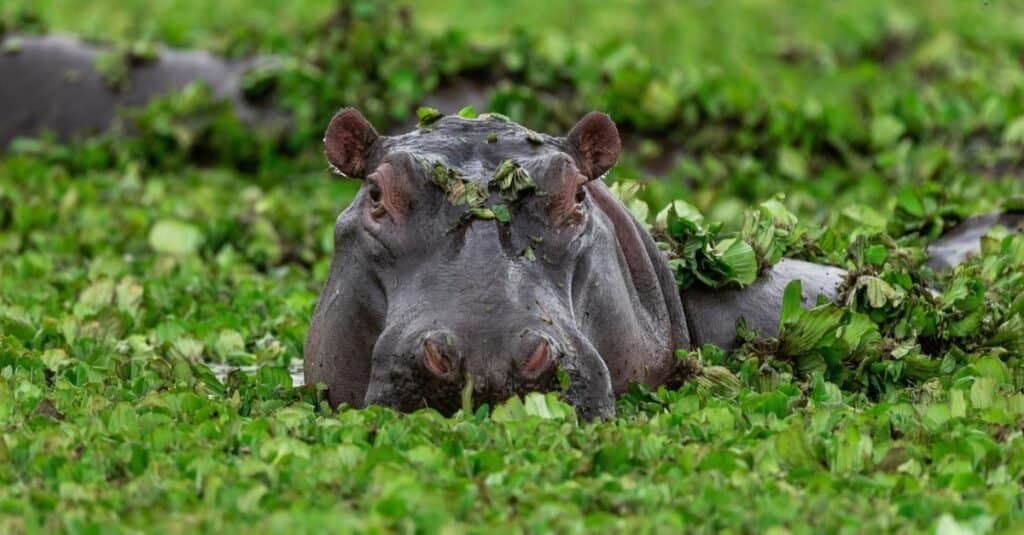
The Hippopotamus, or Hippo, is native to
Africa
.
©nataliatamkovich/Shutterstock.com
The first problem the United States was grappling with in the early 1900s was a major meat shortage. The U.S. struggled to feed its rapidly growing population as cities increased and immigrants flowed across its borders. Further problems like overgrazing and monopolies on meat corporations only amplified the issue.
The second problem was caused by a small plant introduced to the United States during the 1884 World Fair. The Japanese delegation gifted South American water hyacinths to the city of New Orleans. Water hyacinths are beautiful aquatic plants with charming purple flowers.
They are also hardy plants that root in the mud of lakes, rivers, creeks, and ponds. Originally, some people thought these flowers would make great additions to some of the swampy regions in the southern United States.
The problem, however, was that without its natural ecosystem to keep the plant in check, the water hyacinth quickly took over the waterways in Louisiana, blocking shipping routes and choking out fish. Within only 10-15 years, the invasive water hyacinth had completely taken over southern rivers, forming thick mats and chains over 100 miles long.
In some areas, the plants were so thick that the water was impossible to see from the surface! It became so bad that at one point the U.S. Army attempted to eradicate the plants by pouring oil on them and setting the swamp on fire.
Unfortunately for the south, however, water hyacinth seeds are quite robust and can survive for up to 30 years, so the plants simply repopulated over and over and over again.
Broussard’s Plan: “The American Hippo Bill”
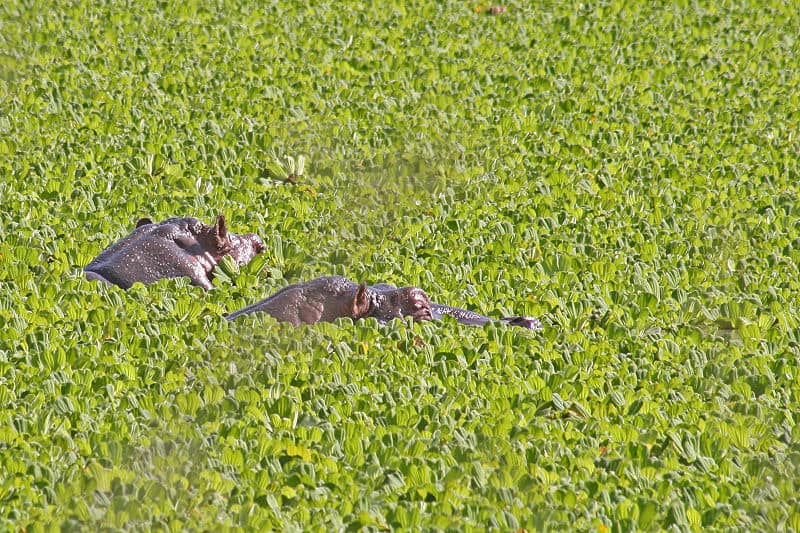
The idea behind the American Hippo Bill was that hippos would eat the invasive water hyacinths.
©Muhammad Mahdi Karim, GFDL, via Wikimedia Commons – License
Robert F. Broussard, Louisiana’s U.S. Representative, took on the seemingly impossible task of solving both the meat shortage and the issue of the invasive water hyacinths. Broussard called upon two very unlikely partners in his pursuit.
The first, Frederick Russell Burnham, was a soldier and adventurer who had lived in Africa since 1893 and was familiar with the continent’s wildlife. The second, Captain Frederick “Fritz” Duquesne, was a big game hunter and a con artist. Strangely enough, both Burnham and Duquesne were bitter enemies who had each been ordered to kill the other during the Second Boer War (orders that neither had successfully carried out).
With the combined knowledge and experience of Burnham and Duquesne, Broussard proposed a rather unusual solution to the United States Government: “House Resolution 23261.”
Also known as the “American Hippo Bill,” this proposal was brought before the U.S. Department of Agriculture on March 24, 1910. The bill would sanction the importation of wild and domestic animals from all over the world into the United States, including, of course, hippopotami from Africa.
The plan was to make the Mississippi River a haven for hippo ranches. The hippos could live in the Mississippi River and surrounding Bayous since they would not need grasslands as cattle do. Hippos, according to Broussard, would eat the water hyacinths, helping to ease the challenges caused by this invasive plant species.
In turn, Americans would domesticate the hippos and raise them for meat to eat. The proposed scheme would cost a quarter of a million dollars (today’s equivalent would be about six million dollars).
Why Hippos?
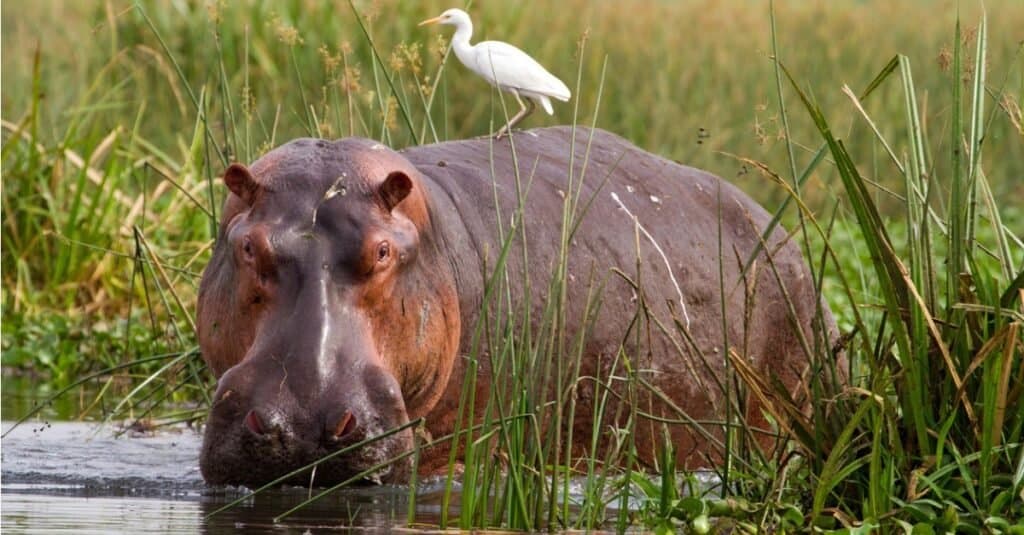
Hippos often spend nearly 16 hours a day in the water.
©iStock.com/PB_Images
Hippopotamuses are mammals well adapted to aquatic environments. They are able to breathe by just having their eyes, ears, and nostrils barely above water.
When underwater, these mammals are capable of holding their breath for 5 minutes or longer with specialized adaptations! While unable to swim or even float, hippos can move along the bottom of waterways easily on their slightly-webbed feet by pushing off of the bottom.
Hippos are omnivores, so they eat both plants and animals. Most of their diet comes from grass, but they also eat fruits and aquatic vegetation—and possibly, water hyacinths. Burnham believed that hippos could adapt to the Americas just as cows, chickens, pigs, and sheep had done in the past.
Additionally, he argued, many other foreign animals had been imported to the Americas and adapted just fine, like ostriches, reindeer, antelope, and African camels. Whereas cattle needed grasslands and pastures for grazing, hippos, they believed, would quickly adapt to the swamps and bayous.
To help make the idea easier to digest, Broussard claimed that eating hippos was a common practice throughout Africa and that in fact, they often made bacon from hippos. The press went crazy over this, with headlines like “Will the meat trust force us to this?” accompanied by a drawing of a large hippo lying on a table, surrounded by well-dressed men and women ready to eat.
Other headlines asked, “How will you have your hippo?” and “Could you eat a hippo?” The New York Times encouraged Americans that eating hippos was just like eating bacon. They called it “Lake-cow bacon,” from the South African term “Zee-Koe speck.”
Solving One Problem with Yet Another Problem
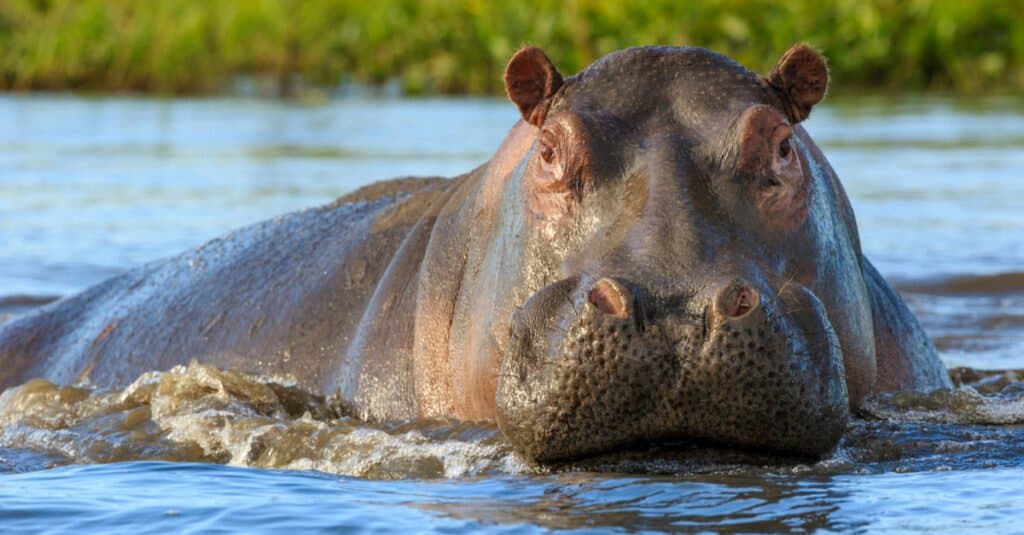
Hippos can eat 80-90 pounds of grass a day.
©Radek Borovka/Shutterstock.com
The American Hippo Bill may sound crazy to us today, but in 1910, it was a very serious proposal for the American government—it was even supported by Theodore Roosevelt, a former U.S. President! In fact, the bill nearly passed, failing by only one vote.
There were, however, several problems with the idea. In the end, it is probably a good thing that the American Hippo Bill was never implemented.
For one, it is generally not a good idea to introduce a non-native species into a new environment. The water hyacinth, of course, is a great example of this. This plant is native to the Amazon basin, and when introduced into America, it became a huge problem for the ecosystems. In fact, the water hyacinth is still a problematic invasive species today.
Louisiana spends a lot of money each year spraying the plants with herbicides and trying to decrease the ever-growing population.
Additionally, since water hyacinths are native to South America—not Africa—it was not a guarantee that hippos would even want to eat these invasive plants. In fact, water hyacinths have now been introduced in Africa, and hippos don’t seem particularly fond of them.
The Problem with Hippos
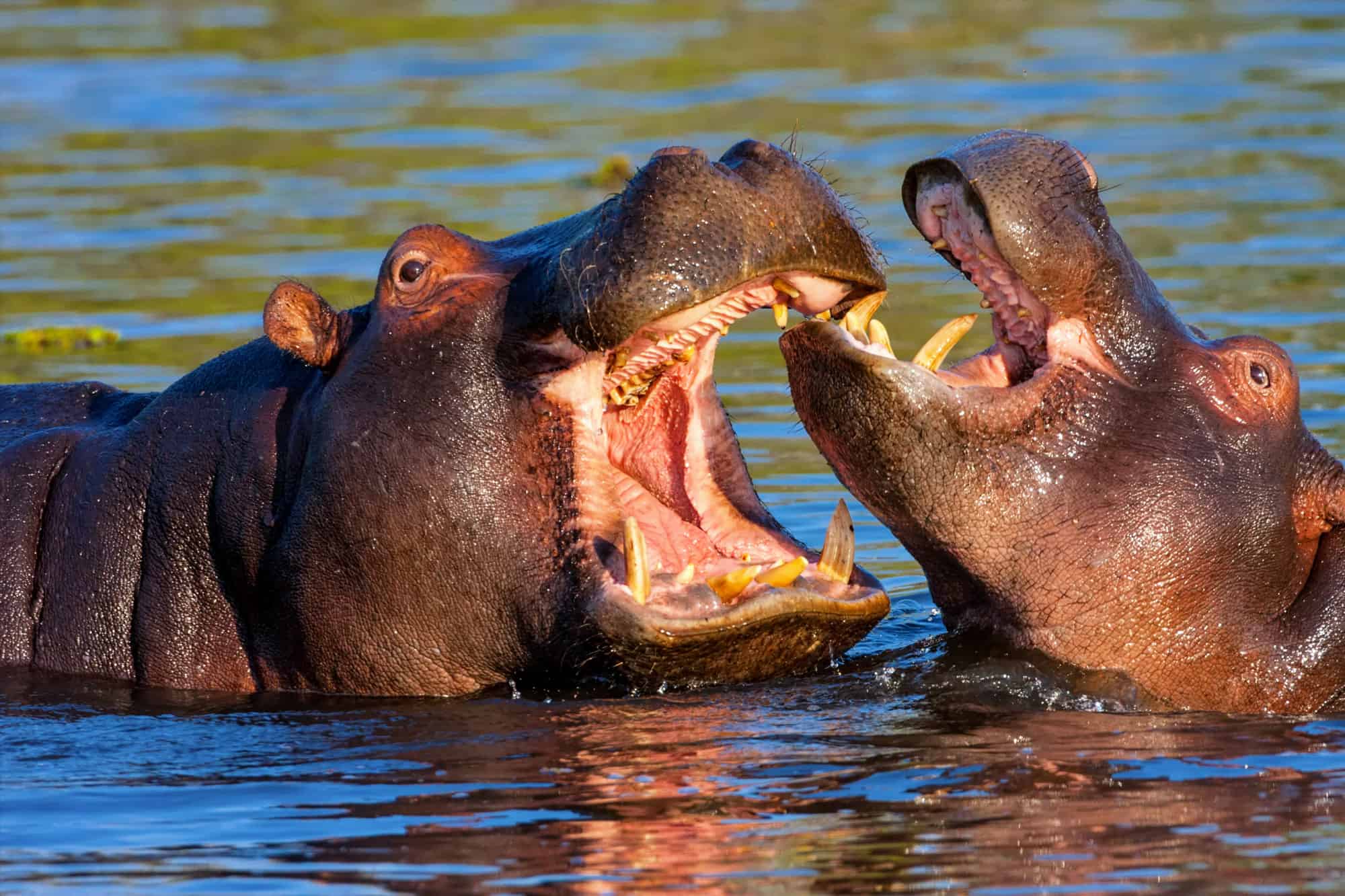
Hippos are capable of producing around 1,800 psi ( 8,100 Newtons) with their bite.
©iStock.com/mesut zengin
Another problem is that hippos are some of the deadliest animals on earth. While they primarily eat plants, hippos have impressively sharp teeth. They also have incredible jaw strength, and they can open their mouths up to 150 degrees!
Hippos can easily crush the skull of any land animal, big or small. They may appear lazy and calm relaxing in the water as they flutter their adorable little ears, but hippos are very unpredictable. They are extremely aggressive, not only terrorizing but killing people and animals in their territories. In Africa, they kill nearly 500 humans every year.

A hippopotamus can hold its breath underwater for up to five minutes.
©cloudzilla / CC BY 2.0 – License
Hippos are one of the largest animals on earth. An adult male hippo can weigh 3,500 to 9,920 pounds! Despite their large size, hippos are also surprisingly fast. They can run 20-30 mph on land (in case you’re wondering, that is faster than most humans can run!).
Hippos can stay underwater for 5 minutes at a time, and move through water at a good speed of 5-7mph, which is where their name comes from. “Hippopotamus” is a Greek word that means “river horse.”
So, as you can imagine, it was probably not the best idea to introduce them to the Mississippi River. In fact, we have a recent example of how introducing hippos into the Americas is not such a good idea.
The “Cocaine Hippos”: A Cautionary Tale
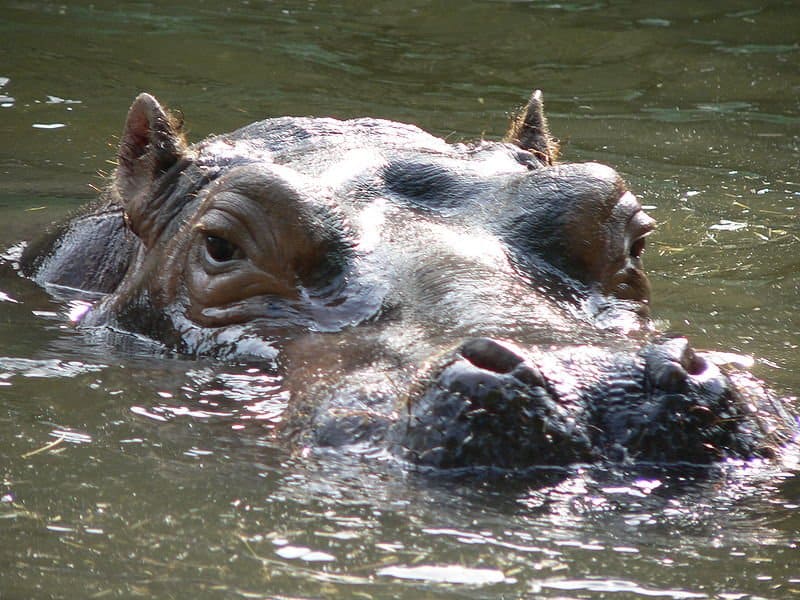
Hippos in Columbia were nicknamed the “Cocaine Hippos,” after their previous owner, Pablo Escobar.
©BS Thurner Hof / Creative Commons – License
In the 1980s, Columbia drug lord Pablo Escobar illegally imported hippos to his Colombian estate as part of his private zoo. When Escobar—known as the “king of cocaine”—died in 1993, the four hippos were left at his ranch, Hacienda Napoles.
While other species from his private zoo were relocated, Escobar’s “cocaine hippos” proved difficult to capture, so they were left behind.
Only four hippos… can’t do that much damage, right? Perhaps… but four hippos—one male and three females—can grow surprisingly quickly. Within only 15 years, those four hippos had spread out beyond Escobar’s estate and multiplied. By 2007, there were now 16 hippos, and by 2020, over 90 hippos lived in and around the Magdalena River Basin!
These feral hippos are now a big problem in Columbia. They impede fishermen, destroy crops, kill cattle, and terrorize nearby villages. In addition, hippo waste affects oxygen levels in the water.
Scientists are now concerned about how this will affect animals and humans, as well as the possible spread of disease. Today scientists are working on sterilizing the hippos to keep them from further multiplying, but as you can imagine, sterilizing a hippo is quite a challenge.
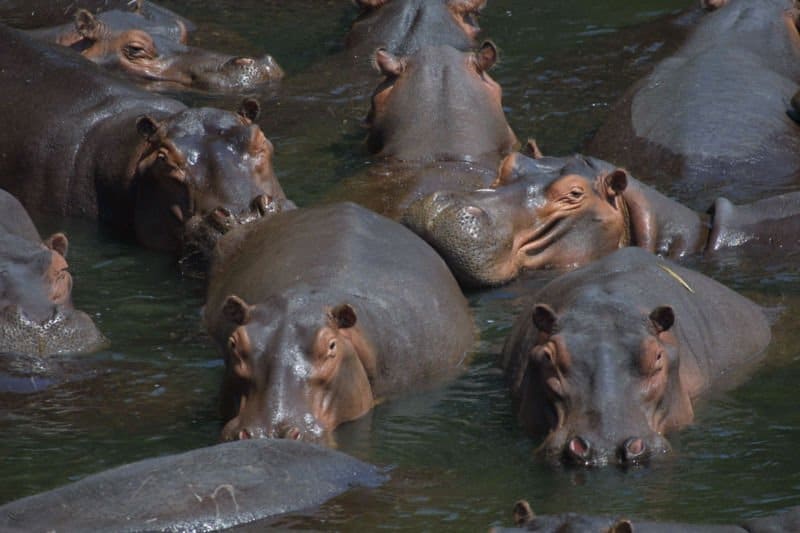
Hippos can eat 80-90 pounds of grass a day.
©Paulmaz at the English language Wikipedia / Creative Commons – License
The photo featured at the top of this post is © iStock.com/ianpjones
FAQs (Frequently Asked Questions)
Where can hippos be found outside Africa today?
Hippos are only native to Africa, but today can be found in South America. The hippos in Colombia were introduced by drug kingpin Pablo Escobar. After his death the hippos ranged out of his compound and are now found across nearly 1,000 square miles of the country.
Thank you for reading! Have some feedback for us? Contact the AZ Animals editorial team.




